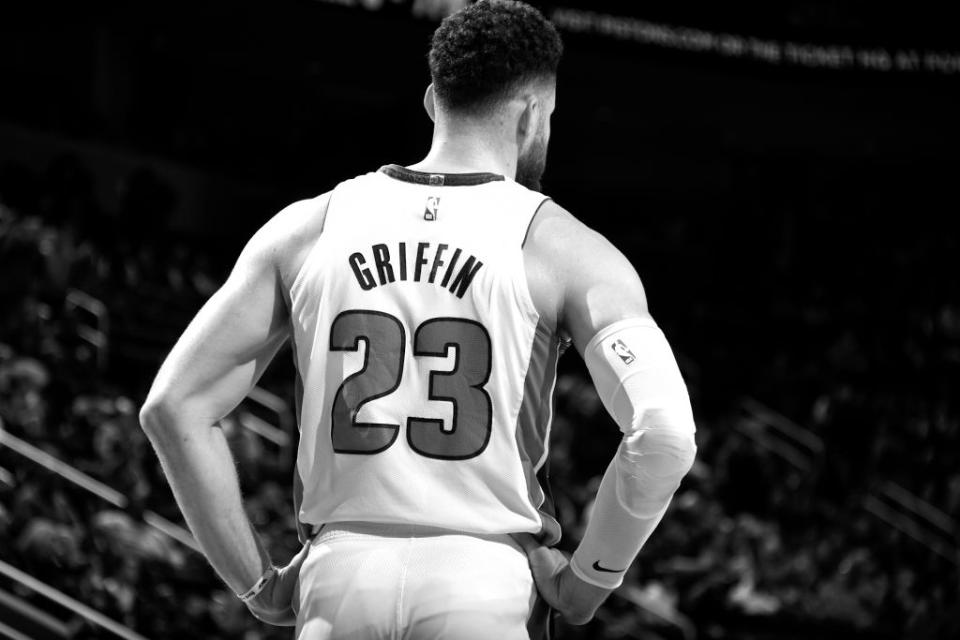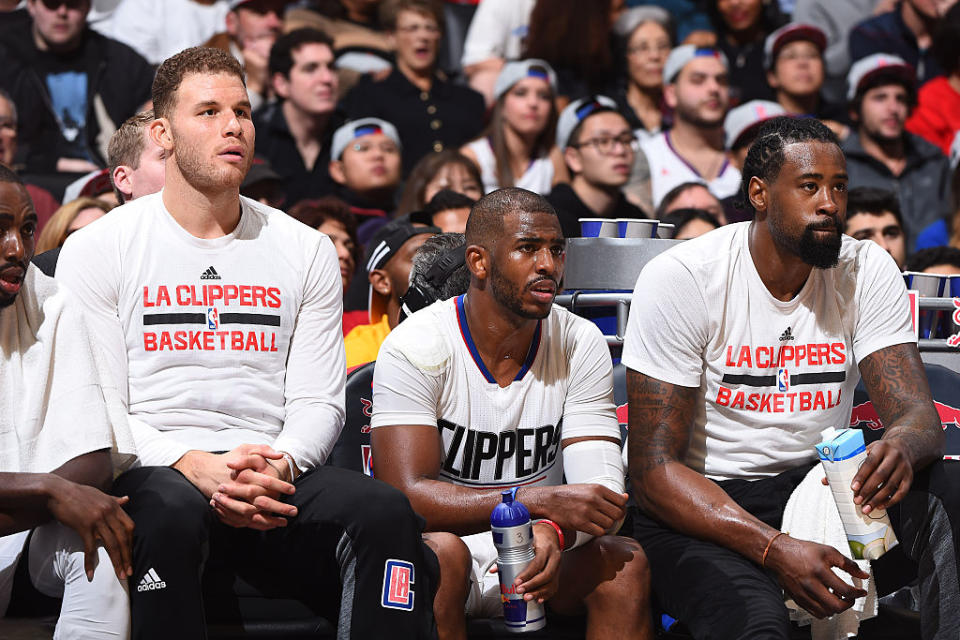On the eve of his Clippers reunion, Blake Griffin's legacy is as complicated as ever

When Blake Griffin burst onto the NBA scene during his 2010-11 Rookie of the Year campaign, he was unlike anyone we’ve ever seen, an evolutionary Charles Barkley exploding over anyone or anything. His size, strength and athleticism, combined with court vision and a malleable shooting stroke, presented infinite possibilities that expanded at an accelerated rate upon the arrival of Chris Paul.
Now, on the eve of his first game in Los Angeles against the Clippers franchise he resurrected, Griffin has been surpassed by a field of unicorns that have all but erased the existence of a position he redefined. Four years after he finished third in the MVP race at age 24, playing alongside DeAndre Jordan in a frontcourt that won 57 games together and had the Clips among the top title contenders, we are convinced he does not fit alongside another All-Star center who leads the league in rebounds.
Left in his wake are L.A.’s Lob City years, a Clippers era defined by unfulfilled championship promise. Those rosters have been picked apart by media and front-office folk alike, but rarely have we stopped to consider: What is Blake Griffin’s legacy? What will it be when all is said and done? What better time to do that than his first return trip to Staples Center to face the Clippers, weeks from the one-year anniversary of the trade that sent him to Detroit for Tobias Harris, Avery Bradley, Boban Marjanovic and a pair of draft picks.
What Blake Griffin was
Griffin averaged 21.6 points, 9.3 rebounds and 4.2 assists per game on better than 50 percent shooting during his tenure in Los Angeles, consistently staying within a whisper of those averages in each of his seven-plus seasons. In half of an idyllic NBA career’s worth of work, he collected more than 10,000 points, 5,000 rebounds and nearly 2,500 assists, making the All-Star team in each of his first five years.
Despite a fractured left kneecap that cost him the entire year after he was drafted No. 1 in 2009 and a string of additional injuries to his right elbow, left quadriceps, right hand, right knee, right big toe and left knee that contributed to him missing another 99 games over his final three seasons in L.A., there always seemed to be something left in the tank. We begged the Clippers to take him out of the garage, awaiting the unveiling of Point Blake and Stretch Blake. We just always wanted more out of Griffin.
For all of his misgivings, most notably that time he punched an equipment manager in the face and the complaining that contributed to the Clippers being “the most hated team by far,” Griffin often gave us more. He became one of the best passing big men of his generation and went from shooting a total of 155 3-pointers in his first six years to matching that number in three months of his final Clips season.
With three top-10 MVP finishes in a five-year span, Griffin was carving out the makings of a Hall of Fame career, and yet none of it was ever enough. By the end of his time in L.A., he had been labeled a locker-room problem, a choke artist and injury-prone, dropping off our All-Star ballots in favor of Anthony Davis, Giannis Antetokounmpo, Draymond Green, Karl-Anthony Towns and Kristaps Porzingis.
Unless your name is LeBron, the measuring sticks for No. 1 picks almost always eventually fall short.
What Blake Griffin is
Don’t get me wrong: Blake Griffin is still a very, very good player, an All-Star in the Eastern Conference.
The unquestioned leader of his team for the first time since his rookie campaign, save for last year’s split season, Griffin is scoring more often (25.1 points per game) and more efficiently (58.8 true shooting percentage) than ever. Credit his career-highs in 3-point attempts (6.4 per game) and percentage (36.2). Pistons coach Dwane Casey quickly learned to turn playmaking duties over to the guy who made the 4/5 pick-and-roll en vogue, so Griffin’s 5.3 assists per game also lead the team.
He’s also stuck in the weird place of not being nearly as good as some of the Big Men Who Can Do Guard Things who came just before and just after him. LeBron and Kevin Durant, both wings who have transitioned to playing the 4 in modern offenses, have risen to historic levels. Antetokounmpo and Davis are well on their way. The ceilings aren’t set yet for young Nikola Jokic, Towns and Porzingis.
Two months before Griffin’s 30th birthday, we think we know what he is — a wildly talented star who cannot be the best player on a championship team and might not be able to carry a very good team.
In two seasons without Paul by his side, Griffin’s teams won 32 and 40 games, and the Pistons are headed for a 36-win season this year. That complicates his legacy, because we can’t imagine how someone who averages a 25-8-5 every night with decent talent around him would not make the playoffs in the East.
This is nothing new. We wondered for years, “Are the Clippers better without Blake Griffin?” Which would seem like a ridiculous question to ask about a player of his caliber if there weren’t mounting evidence to support it. The Lob City Clippers finished 53-34 without Griffin in the lineup, including a nine-game win streak in 2015-16 and a seven-game win streak in 2016-17 that left us to wonder if the Clips were better served doling out his 30 percent usage rate to the rest of a talented team.
We should never wonder that about someone who once seemed like a perennial MVP candidate, and yet that’s where we are with Griffin. He has continued to compile an impressive statistical résumé in Detroit, where he may well spend the rest of his prime without ever being taken seriously, and when he had the chance to deliver in Los Angeles, his seasons always ended in disappointment. We tend to transfer that same label to his entire playing career, but as usual, it’s more nuanced than that.

What Blake Griffin could have been
We cannot properly evaluate the shortcomings of Griffin’s teams without taking a year-by-year look at what went wrong for the Lob City Clippers, because the totality of that failure is something to behold.
2011-12: In their first season together, a lockout-shortened campaign that left little time to jell, the triumvirate of Griffin, Paul and Jordan won 60 percent of their games, earned a No. 5 seed and took the Grit-n-Grind Memphis Grizzlies out in a seven-game first-round series before getting their doors blown off by the veteran-laden and superior San Antonio Spurs in a second-round sweep. Not bad.
2012-13: The 56-win and fourth-seeded Clips fell in six games to those same Grizzlies in the first round, if only because Griffin suffered a high-ankle sprain that limited him to just 20 and 14 minutes in the Games 5 and 6 losses. The injury was bad enough that he came off the bench in the Game 6 defeat.
2013-14: In another seven-game first-round series, the 57-win and third-seeded Clippers eliminated a Golden State Warriors team that was still a year away from winning its first of three rings. They lost in six games to Durant and the Oklahoma City Thunder in the conference semifinals, largely because of Paul’s legendary collapse in the final minute of Game 5. Even Paul took the blame for that one.
2014-15: The 56-win and third-seeded Clippers ousted the defending champion Spurs in yet another seven-game series in the first round. With the Clips about to advance to their first-ever conference finals, despite losing Paul to a hamstring injury for the first two games of their second-round series against the Houston Rockets, they suffered another all-time collapse in Game 6. They blew a 19-point second-half lead at home to a Houston team that had benched James Harden and was riding Josh Smith. Ugly.
2015-16: The 53-win and fourth-seeded Clippers lost in six games to the Portland Trail Blazers in the first round, courtesy of season-ending injuries suffered by both Griffin and Paul in Game 4.
2016-17: The 51-win and fourth-seeded Clippers lost in seven games to the Utah Jazz in the first round, only after Griffin’s season ended prematurely once again with a big-toe injury suffered in Game 3.
We see now five 50-win seasons that resulted in zero conference finals appearances. We remember the injuries, which might have cost the Clippers two or three chances to make the third round. They definitely cost Griffin his last two chances to make Lob City work. We remember the two collapses, which cost the Clips back-to-back shots at the Spurs and the Warriors with the NBA Finals on the line.
What we don’t remember is that those Clips took out the Warriors at the start of their dynasty and the Spurs at the end of theirs. We don’t remember that Griffin was the best player on the court in a seven-game series against the Warriors or that he dropped a 24-13-10 triple-double in Game 7 against the Spurs. Paul’s Game 5 against the Thunder erased 24 points and 17 rebounds from Griffin, who also scored 28 and 27 points, respectively, in the final two games of the 2015 collapse against the Rockets.
Had even one of those stumbling blocks fallen in his favor, we would have seen Griffin on grander stages — the conference finals, for sure, and maybe an NBA Finals — but none of them broke his way. He would be remembered so differently were it not for a handful of losses largely beyond his control.
“I’m not saying that what I accomplished with the Clippers is my legacy or my success — I don’t mean all that,” Griffin told ESPN’s Kevin Arnovitz this week. “But what was expected of me or of that situation, it was surpassed. So I don’t care. I really don’t. That’s how I look at — that’s as honest as I can put it. There are things that I wish went differently, of course. But I learned a lot and I got to play with a lot of great players. I got to play in some really awesome games — fun games, big games. I had some big experiences.
“Now I’ve moved on.”
Griffin certainly surpassed expectations at the outset of his career, elevating a Clippers franchise that was once the laughingstock of the league to respectability — so much so that the NBA’s biggest free agents this coming summer are expected to consider them as a viable option. But his performance and partnership with two other All-Stars raised those expectations so much over the course of his tenure in L.A. that they ultimately fell short. Once again, Griffin is stuck somewhere between two tiers.
What Blake Griffin will be
Basketball Reference’s statistical player comparisons for Griffin are littered with players on either side of the Hall of Fame bubble. Based on their blend of athleticism and skill, the two best comps of the bunch from the past three decades are probably fellow dunk artists Dominique Wilkins and Shawn Kemp. They too have complicated legacies, as do most players without rings.
Wilkins was a more electrifying scorer, leading the league in that category in 1985-86 and twice eclipsing 30 points per game for a season. He was the best player on an Atlanta Hawks team that won 50 games in four straight seasons in the mid-1980s and never reached the conference finals, mostly because the East was stacked with Pistons and Boston Celtics teams that won multiple titles. He scored 47 points in Game 7 of a 1988 conference semifinals loss to Boston that will live on forever.
Kemp wasn’t the shooter or playmaker Griffin is, but he was every bit the overpowering monster, and he made the All-Star team each season for a six-year stretch that included a 1996 Finals appearance. In a shallower Western Conference, Kemp’s Seattle SuperSonics did what Griffin’s Clippers could not, sweeping Hakeem Olajuwon’s two-time defending champion Houston Rockets in the second round and beating Karl Malone’s Utah Jazz in seven games to emerge from his half of the bracket. A few years later, by his 30th birthday, Kemp was out of shape and starting to play his way out of the league.
Wilkins was somehow not a first-ballot Hall of Famer, although they rectified that on the second, and Kemp is still awaiting his call a decade after his eligibility. Griffin falls somewhere in between them.
If Griffin maintains his career averages — 21.7 points, 9.1 rebounds and 4.4 assists — over the course of his current contract, which will pay him $39 million in 2021-22 (likely keeping him in Detroit until then), he will have amassed roughly 17,000 points, 7,000 rebounds and 3,500 assists by age 33. That would put him among the top 100 all time in points and rebounds and top 200 in assists. Only nine other bigs in NBA history have reached those plateaus: Kareem Abdul-Jabbar, Karl Malone, Wilt Chamberlain, Dirk Nowitzki, Tim Duncan, Kevin Garnett, Charles Barkley, Pau Gasol and and Chris Webber.
The only Hall-eligible player of that bunch not in Springfield: Webber. He made one First Team All-NBA roster in 2001 and one conference finals (*cough* should have been a Finals appearance *cough*) in 2002, two line items Griffin does not have on his résumé. But in almost every other regard, they are highly comparable, right down to their stat lines (Webber averaged a 20.7-9.8-4.2 over 15 seasons). Griffin is the C-Webb of his generation, and that is an amazing player — a should-be Hall of Famer.
Perhaps the best summation of Griffin’s legacy came from Clips president of basketball operations Lawrence Frank, who told The Athletic’s Jovan Buha this week, “Blake is one of the greatest Clipper players.” Greatest Clipper is the perfect encapsulation of Griffin, a player who has straddled the line between wild success and massive disappointment, Hall of Famer and snub, pioneer and throwback.
– – – – – – –
Ben Rohrbach is a staff writer for Yahoo Sports. Have a tip? Email him at rohrbach_ben@yahoo.com or follow him on Twitter! Follow @brohrbach
More from Yahoo Sports:
• Cardinals clap back at ESPN’s Stephen A. Smith
• Coach gives Saints $225K reasons to be motivated
• MVP performance: Giannis outduels Harden
• Paylor: How Mahomes can help Chiefs avoid playoff flop


